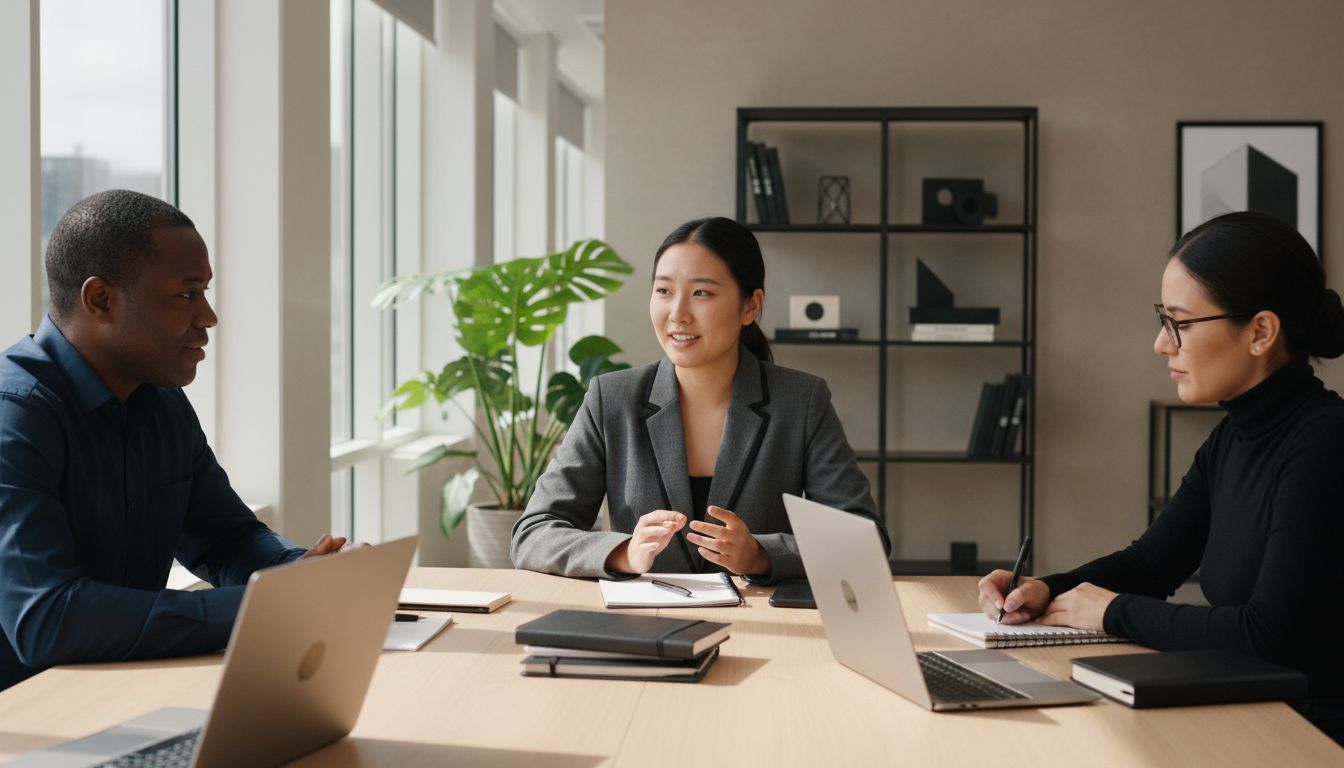Master Video Interview Best Practices for Job Success
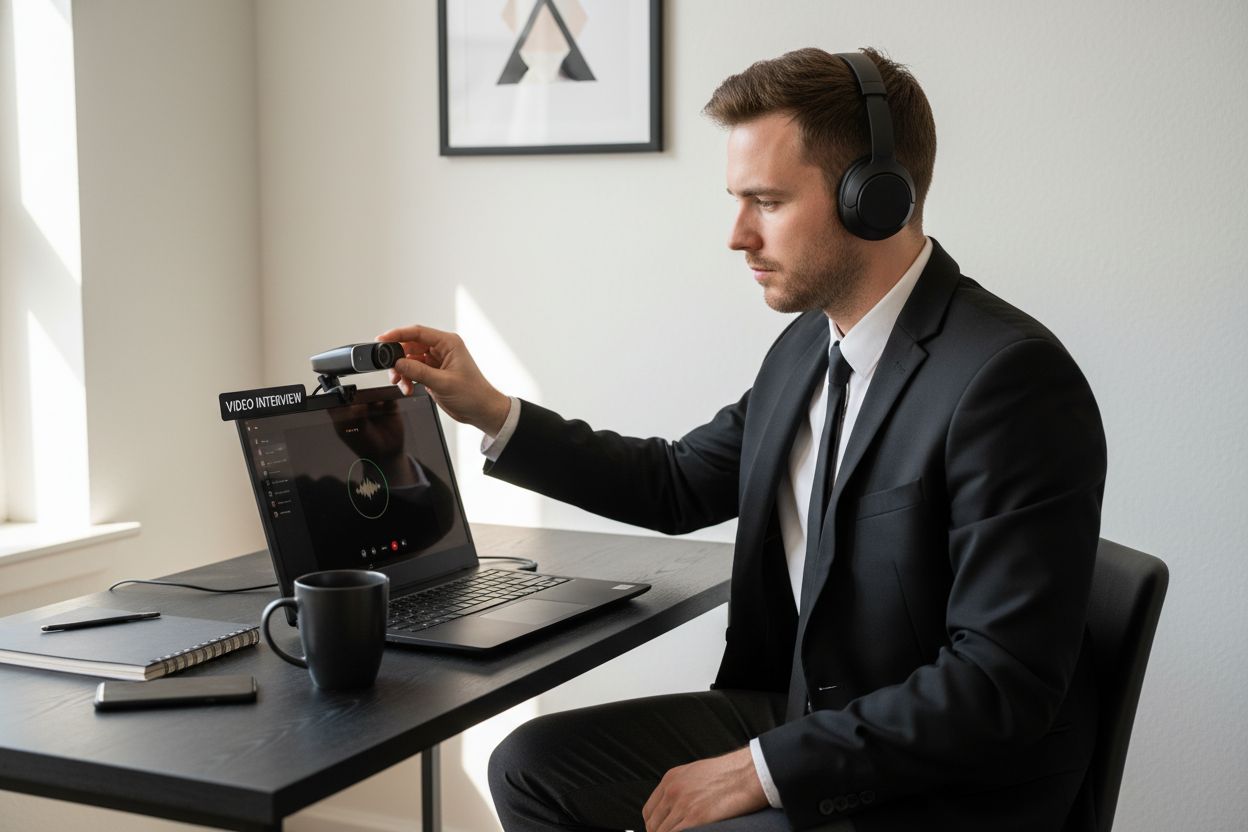
Video interviews have become a crucial gateway to landing top jobs, with over 60 percent of employers now using virtual meetings as their main interview method. Plenty of people worry that a technical glitch or awkward camera angle could cost them the offer. Most people obsess over what to say, but the truth is your setup, clothing, and follow-up messages often matter just as much as your answers.
Table of Contents
- Step 1: Prepare Your Technology And Environment
- Step 2: Dress Professionally For The Interview
- Step 3: Practice Common Interview Questions
- Step 4: Engage With The Interviewer Actively
- Step 5: Follow Up After The Interview
Quick Summary
| Key Point | Explanation |
|---|---|
| 1. Test your technology beforehand | Ensure all equipment is functional at least 48 hours before the interview to avoid technical issues during the call. |
| 2. Dress professionally from head to toe | Wear complete professional attire to maintain a polished appearance even if only your torso is visible on camera. |
| 3. Practice interview questions effectively | Develop flexible communication strategies by practicing responses and recording yourself to refine your delivery and body language. |
| 4. Engage actively with the interviewer | Demonstrate genuine interest through eye contact, active listening, and thoughtful questions to create a dynamic conversation. |
| 5. Follow up promptly after the interview | Send a personalized thank-you email within 24 hours that references specific discussion points to reinforce your candidacy and professionalism. |
Step 1: Prepare Your Technology and Environment
Successful video interviews begin with meticulous technological preparation. Your digital environment can make or break your first impression, transforming a potential opportunity into a professional showcase. The right setup demonstrates technical competence and signals your commitment to the interview process.
Start by selecting a reliable device with a high-quality camera and microphone. Your laptop, desktop, or tablet should support stable video conferencing platforms like Zoom, Microsoft Teams, or Google Meet. Critically test your equipment at least 48 hours before the interview to identify and resolve any potential technical issues. This preparation prevents last-minute scrambling and reduces interview anxiety.
Create a professional background that reflects your personal brand and maintains a distraction-free environment. Choose a neutral, clean space with good natural lighting or soft, consistent artificial lighting. Position yourself facing a plain wall or a curated background that looks professional but not sterile. Avoid busy patterns, cluttered rooms, or spaces with moving elements that could draw attention away from you.
Your internet connection is the invisible backbone of your video interview. Hardwired ethernet connections provide the most stable connection, but if using wifi, position yourself close to your router and minimize simultaneous internet usage by other household members. Run a speed test to confirm your upload and download speeds meet video conferencing requirements. Aim for at least 10 Mbps download and 5 Mbps upload speeds to ensure smooth, uninterrupted communication.
Sound quality matters as much as visual clarity. Test your microphone and audio levels beforehand, using headphones with a built-in microphone for optimal sound clarity. Eliminate background noise by choosing a quiet room and informing household members about your interview time. Close windows, silence mobile devices, and consider using noise-canceling software if ambient sounds are unavoidable.
Finally, have a backup plan. Keep a phone number for your interviewer readily available, and have an alternative device or internet connection prepared. Learn more about tech interview preparation to ensure you’re comprehensively ready. By systematically addressing these technological elements, you transform potential technical vulnerabilities into a demonstration of your professionalism and preparedness.
Below is a quick-reference checklist of essential video interview technology preparations to help ensure a smooth, professional experience.
| Preparation Step | Purpose | How to Verify |
|---|---|---|
| Test camera and microphone | Ensure clear video and audio | Use conferencing app or recording tool |
| Select professional background | Maintain a distraction-free, branded setting | Review appearance on video preview |
| Check internet connection | Support stable call quality | Run speed test for minimum 10 Mbps down, 5 Mbps up |
| Optimize lighting | Ensure clear, flattering image | Position light in front, adjust as needed |
| Eliminate background noise | Prevent distractions | Use headphones, close doors/windows |
| Prepare backup plan | Minimize disruptions | Have alternate device and interviewer contact ready |
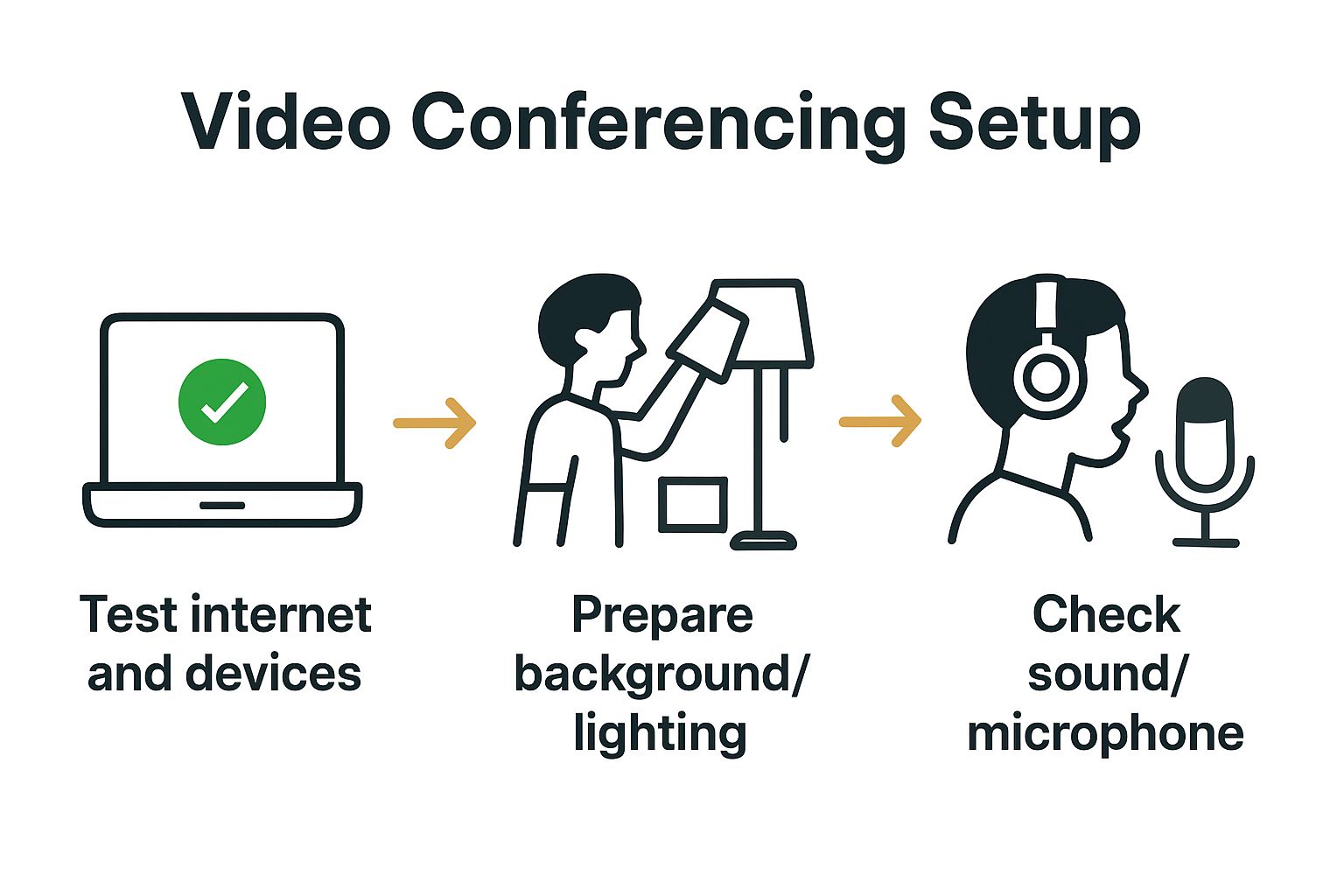
Step 2: Dress Professionally for the Interview
Your video interview attire speaks volumes before you utter a single word. Professional clothing communicates respect, competence, and serious intent about the opportunity. While virtual interviews offer some flexibility, they demand the same sartorial thoughtfulness as in-person meetings.
Corporate dress codes have evolved, but fundamental principles of professional presentation remain consistent. Select clothing that fits well, appears crisp on camera, and reflects the professional culture of your target industry. Solid colors work best for video interviews, avoiding busy patterns or bright whites that can create visual distortions on screen. Dark navy, charcoal gray, or muted tones project confidence and maintain a polished appearance.
Consider the complete visual package, not just your upper body. Although only your torso might be visible, wear complete professional attire in case you need to stand or adjust your position. This approach prevents awkward moments and reinforces your preparedness. Choose well-fitted business formal or business casual attire depending on the company’s culture. A tailored blazer, button-down shirt, or professional blouse communicates immediate credibility.
Color psychology plays a subtle yet significant role in professional presentations. Select colors that convey trustworthiness and competence. Blues suggest reliability, grays communicate sophistication, and muted earth tones indicate groundedness. Avoid overly bright or neon colors that might distract from your communication. Your goal is to present a balanced, professional image that allows your skills and personality to shine through.
Accessories and grooming require strategic consideration for video interviews. Minimal, professional jewelry prevents visual clutter. Ensure your hairstyle appears neat and controlled. If you wear glasses, position them to minimize glare from your computer screen. Subtle makeup or a clean-shaven appearance maintains a professional aesthetic. Learn more about interview preparation strategies to refine your approach.
Remember that your clothing choices are a form of non-verbal communication. They signal your understanding of professional standards, attention to detail, and respect for the interview process. By carefully curating your video interview wardrobe, you demonstrate that you take the opportunity seriously and are prepared to represent yourself as a polished, professional candidate.
The table below summarizes the influence of different clothing choices and grooming elements on your overall video interview presentation.
| Clothing/Grooming Element | Impact on Presentation | Recommendation |
|---|---|---|
| Shirt/Blouse Color | Visual clarity and professionalism | Solid, muted tones (navy, gray, earth tones) |
| Patterns and Whites | Can cause visual distractions or glare | Avoid busy patterns and bright whites |
| Complete Outfit | Prevents awkwardness if you stand/change position | Dress fully in business attire, head-to-toe |
| Accessories | Maintain a clean, uncluttered look | Use minimal, professional jewelry |
| Hair and Makeup | Reflects attention to detail | Neat hairstyle, subtle makeup or well-groomed |
| Glasses Positioning | Reduces screen glare | Adjust to minimize reflections |
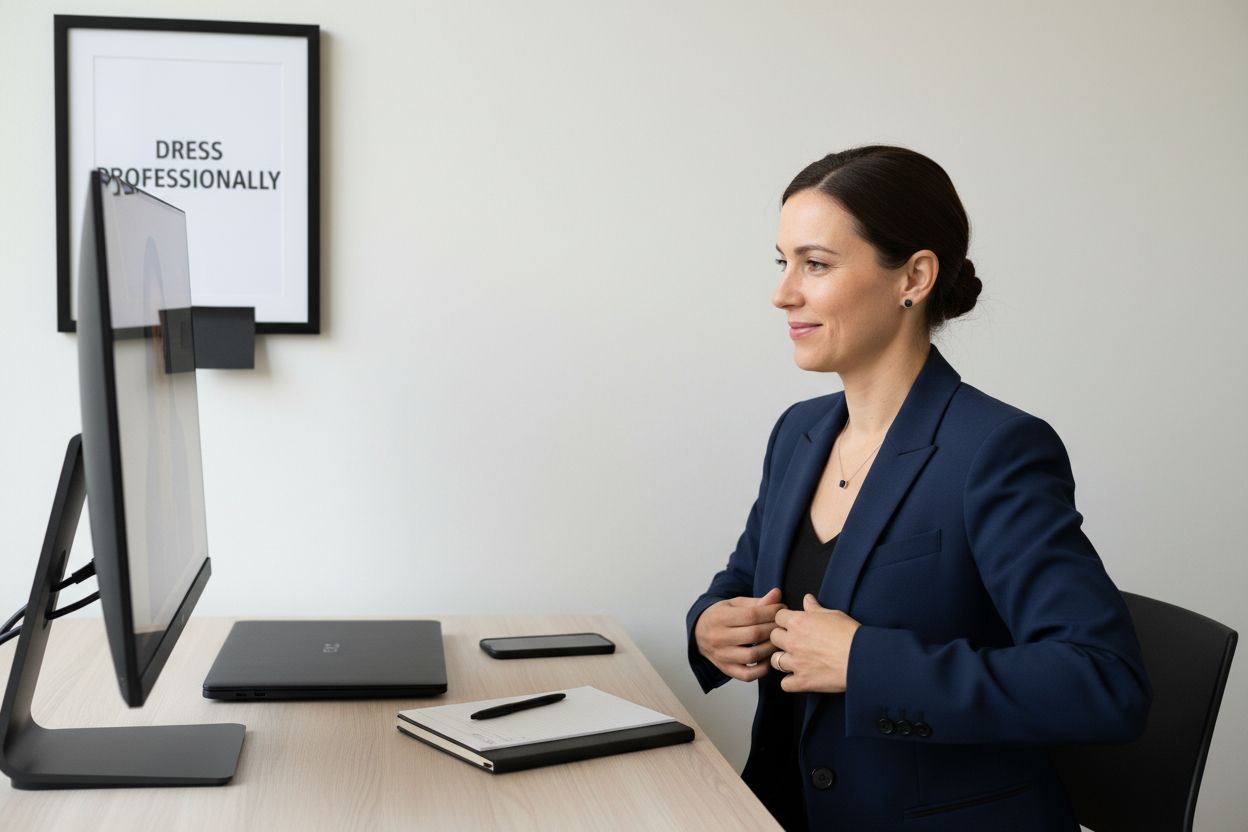
Step 3: Practice Common Interview Questions
Successful video interviews demand strategic preparation through targeted question practice. Your ability to articulate clear, concise responses demonstrates professional communication skills and builds interviewer confidence. The goal is not to memorize answers but to develop flexible, authentic communication strategies that reveal your unique professional strengths.
Begin by identifying the most frequent interview questions across your industry. Classic inquiries like “Tell me about yourself,” “What are your greatest strengths and weaknesses,” and “Why do you want to work here?” form the foundation of most interview conversations. Craft responses that blend personal narrative with professional achievements. Practice transforming generic answers into compelling stories that highlight your skills, experience, and potential value to the organization.
Recording yourself during practice sessions provides transformative insights. Use your computer or smartphone to capture video responses, allowing you to evaluate your body language, tone, and communication clarity. Pay special attention to your eye contact, which means looking directly into the camera to simulate genuine engagement. Analyze your recordings objectively, noting areas where you can improve vocal modulation, reduce filler words like “um” or “like,” and refine your narrative structure.
Role-playing with a trusted friend or mentor can simulate real interview dynamics. Request honest feedback about your communication style, ensuring your responses feel natural and authentic. Some individuals benefit from structured practice frameworks, while others excel with more conversational preparation. Explore comprehensive interview question strategies to develop a personalized approach that matches your communication strengths.
Develop a mental toolkit of response techniques that work across various question types. The STAR method (Situation, Task, Action, Result) helps structure compelling narrative responses for behavioral questions. Prepare concrete examples from your professional experience that demonstrate problem-solving, leadership, and adaptability. Anticipate potential follow-up questions and practice transitioning smoothly between different professional experiences and skills.
Remember that interview preparation is about building confidence through competence. Your practice should feel like a strategic conversation, not a rigid performance. By investing time in thoughtful, nuanced preparation, you transform potential interview anxiety into a powerful opportunity to showcase your professional capabilities.
Step 4: Engage with the Interviewer Actively
Active engagement transforms a standard video interview from a passive question-and-answer session into a dynamic professional conversation. Your goal is to demonstrate genuine interest, attentiveness, and interpersonal intelligence through intentional communication strategies that go beyond scripted responses.
Nonverbal communication becomes critically important in video interviews. Position yourself to maintain consistent eye contact by looking directly into the camera, which simulates direct eye contact with the interviewer. This subtle technique creates a sense of connection and engagement that transcends digital distance. Practice maintaining a relaxed yet attentive posture that communicates confidence and professionalism. Small details like slight forward leaning and occasional natural nodding signal your active listening and genuine interest in the conversation.
Listening represents a powerful yet often overlooked engagement technique. Resist the impulse to formulate your next response while the interviewer is speaking. Instead, focus entirely on understanding their questions and underlying implications. Use verbal affirmations like “I understand” or “That’s an interesting point” to demonstrate active listening. When responding, reference specific elements from the interviewer’s questions to show you’ve been paying close attention and are crafting thoughtful, contextual answers.
Prepare strategic questions that demonstrate your research and genuine curiosity about the role and organization. These inquiries should reveal your professional insight and commitment. Thoughtful questions might explore team dynamics, upcoming projects, or the organization’s strategic goals. Explore advanced interview engagement techniques to refine your approach and stand out as a candidate.
Be prepared to adapt your communication style to the interviewer’s energy and pace. Some interviewers prefer more structured interactions, while others enjoy more conversational exchanges. Reading and mirroring their communication approach subtly demonstrates your emotional intelligence and professional adaptability. Pay attention to their tone, speaking speed, and level of formality, and adjust your responses accordingly.
Remember that engagement is a two-way interaction. Your objective is to transform the interview from an interrogation into a collaborative exploration of your potential contribution. By approaching the conversation with genuine curiosity, active listening, and strategic communication, you position yourself not just as a candidate, but as a potential valuable team member.
Step 5: Follow Up After the Interview
The interview doesn’t end when you disconnect from the video call. Strategic follow-up communication can distinguish you from other candidates and demonstrate your professionalism, attention to detail, and genuine interest in the position. Your post-interview approach should be thoughtful, timely, and purposeful.
Within 24 hours of your interview, send a personalized thank-you email to each interviewer. This communication is more than a courtesy it’s a strategic opportunity to reinforce your candidacy. Craft a message that references specific conversation points from your interview, highlighting your understanding of the role and reaffirming your enthusiasm. Mention particular moments or discussions that resonated with you, showing that you were actively engaged and reflective during the conversation.
Personalization is key in your follow-up communication. Generic, templated emails signal minimal effort. Instead, reference specific projects discussed, challenges the team is facing, or insights shared during the interview. This approach demonstrates that you were not just answering questions, but genuinely listening and processing the conversation. Proofread your email meticulously, ensuring perfect grammar and professional formatting. A single typo can undermine the carefully crafted impression you’ve worked to establish.
Consider the timing and frequency of your follow-up communications. While a thank-you email should be sent within 24 hours, subsequent check-ins require careful strategic planning. Explore professional follow-up strategies to understand the delicate balance between showing continued interest and avoiding perceived desperation. If you haven’t heard back within the timeline discussed during the interview, a polite and concise inquiry after one week is appropriate.
Preserve professional communication channels throughout your follow-up process. Use the same email address and contact method established during the interview process. Maintain a tone of respect, gratitude, and continued enthusiasm. Your goal is to remain memorable in a positive, professional context. Document your follow-up communications, noting dates and key points discussed, to help you track your application progress and prepare for potential future interactions.
Remember that follow-up is an extension of your interview performance. It’s an opportunity to reinforce the positive impression you’ve created, demonstrate your communication skills, and show that you are a candidate who goes above and beyond. Approach each follow-up interaction with the same intentionality and professionalism you brought to the interview itself.
Take Control of Your Next Video Interview With Real-Time Support
You have just read how critical it is to master technology, prepare answers, and handle interview nerves. But even with the best preparation, the fear of forgetting what to say or stumbling over tough questions is real. Many job seekers worry about losing focus or not being able to think on their feet, especially when the pressure is high on camera. Imagine how much more confident you would feel knowing you never have to face these obstacles alone.
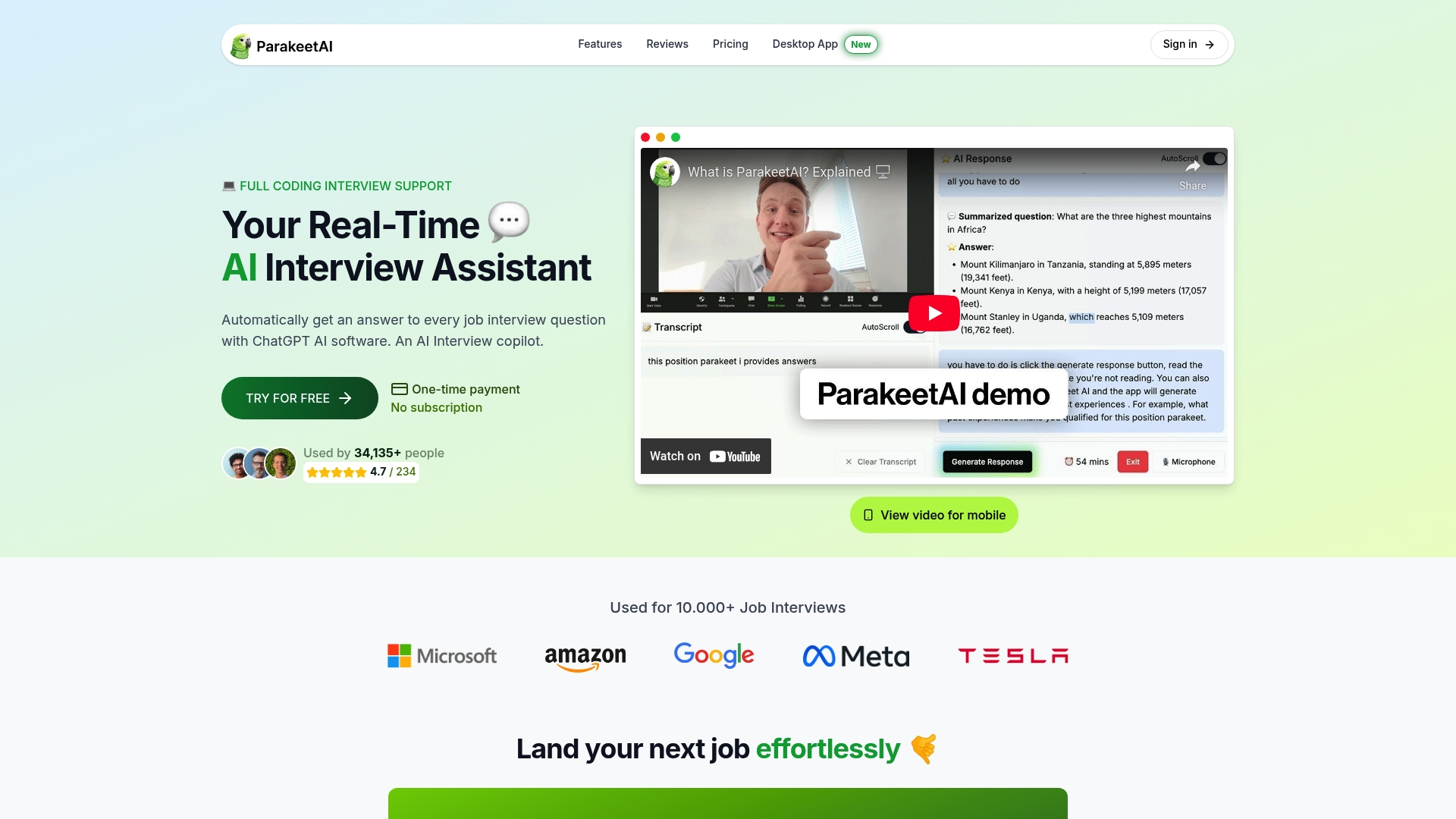
Get instant, AI-powered support right when you need it most. Our real-time AI job interview assistant actively listens to your live interview and gives you personalized answer suggestions for every question. No more awkward silences or worries about missing key points. Visit https://parakeet-ai.com now to turn every next video interview into a true showcase of your skills. Start your journey toward success with the technology on your side today.
Frequently Asked Questions
How can I prepare my technology for a video interview?
Successful video interview preparation includes testing your camera and microphone, creating a distraction-free background, ensuring a stable internet connection, and having backup options ready.
What should I wear for a video interview?
Dress professionally by choosing well-fitted, solid-colored attire that reflects the company’s culture. Avoid busy patterns and bright whites, and consider the complete visual package, including accessories and grooming.
What common interview questions should I practice?
Focus on frequent questions like “Tell me about yourself,” “What are your strengths and weaknesses?” and “Why do you want to work here?” Craft responses that incorporate your experiences and achievements into compelling narratives.
How can I actively engage with the interviewer during a video interview?
Engage by maintaining eye contact with the camera, practicing active listening, referencing conversation points, and adapting your communication style to match the interviewer’s tone and pace.
Recommended
- Master Video Interview Questions and Answers in 2025
- video interview questions and answers - ParakeetAI
- 7 Essential Job Interview Tips for Success in 2025
- How to Answer Interview Questions Confidently: Tips & Strategies
- Warning Signs In An Interview That There Could Be A Management Maturity Issue - Berriault and Associates Consulting Group
- Master Step by Step Video Analysis for Impactful Insights


